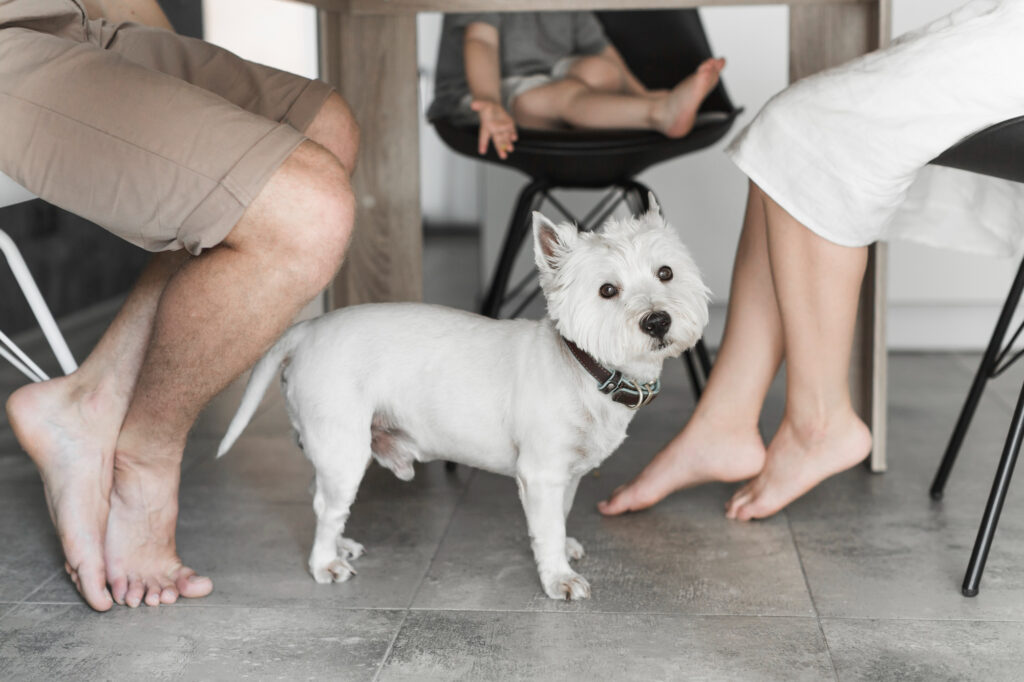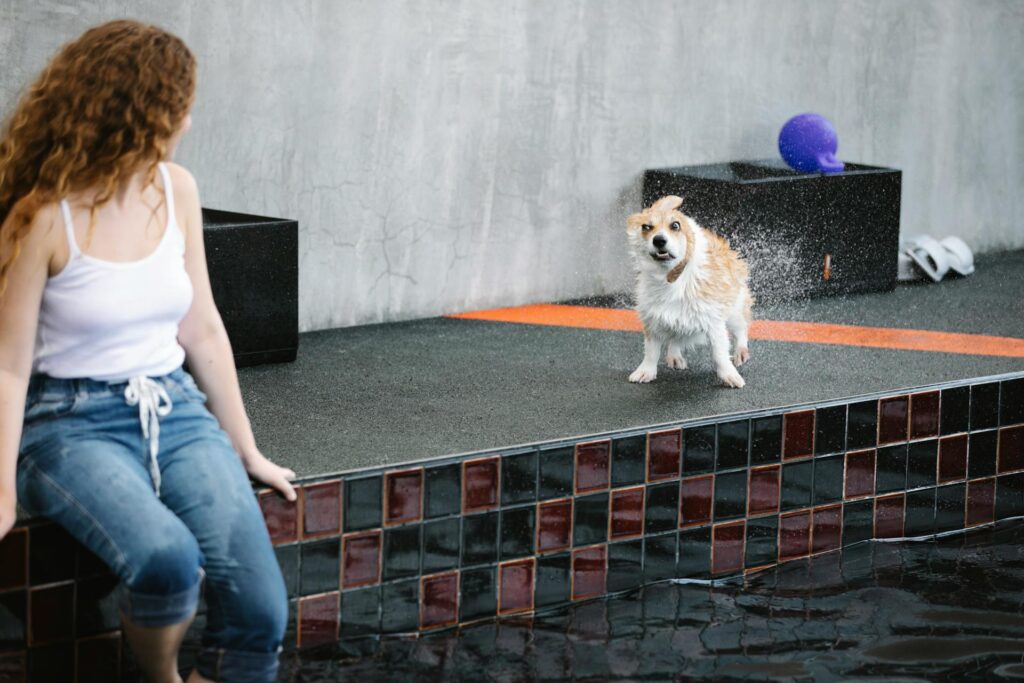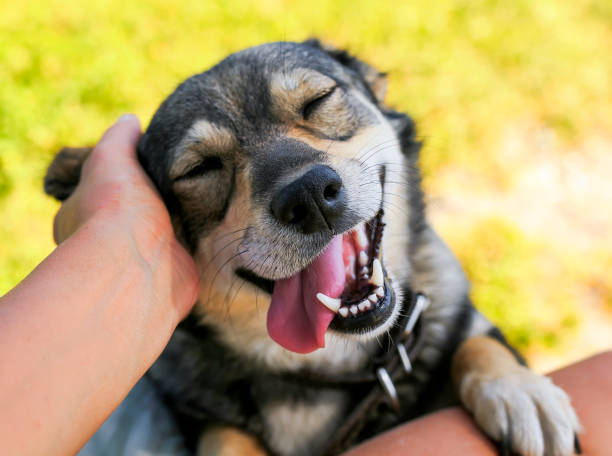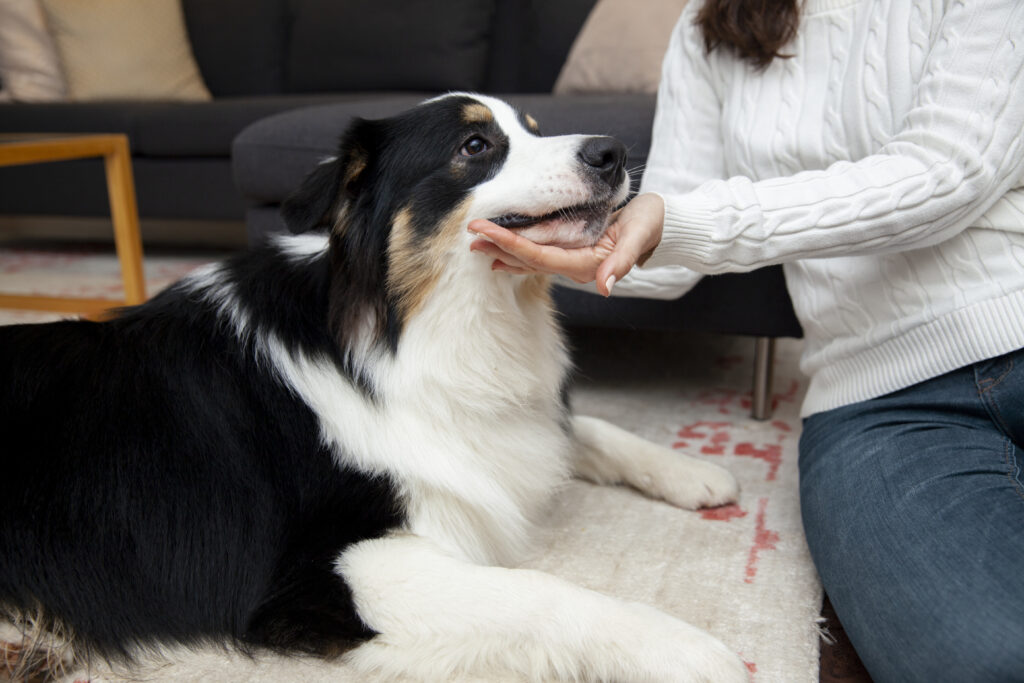
Have you ever noticed your dog doing something that seems out of place or a bit odd, like scratching when they aren’t itchy, yawning when they’re not tired, or licking their lips when there’s no food around? These quirky actions might be examples of what is known as displacement behavior. Understanding displacement behavior in dogs can help you better understand what your furry friend is feeling and how to respond to their needs.
In this article, we’ll explore what displacement behavior is, why dogs display these behaviors, and how you can identify them. We’ll also provide tips on what to do if your dog shows signs of displacement behavior. The language here will be simple and straightforward, making it easy for anyone to understand.
What is Displacement Behavior?
Displacement behavior refers to actions that seem out of context or unrelated to the situation at hand. These behaviors often occur when a dog is experiencing conflicting emotions, such as stress, anxiety, or excitement. Essentially, when a dog doesn’t know how to react to a situation, they might engage in a behavior that helps them cope with their emotions, even if that behavior seems unrelated to what’s going on.
For example, if a dog is unsure whether to approach another dog or back away, they might suddenly start scratching or licking themselves as a way to deal with their uncertainty. These actions are not directly related to the situation but serve as a way for the dog to release some of their pent-up energy or stress.
Also Read: What to Know as a First Time Dog Owner? A Comprehensive Guide
Common Displacement Behaviors in Dogs
There are several common displacement behaviors that you might notice in your dog. While these behaviors can be normal in certain contexts, it’s important to recognize when they might be a sign that your dog is feeling stressed or anxious.
-
Yawning
Yawning is one of the most recognizable displacement behaviors in dogs. While dogs do yawn when they’re tired, they also yawn when they’re feeling stressed, anxious, or uncertain. If you notice your dog yawning frequently in situations where they wouldn’t typically be tired—like during a training session or when meeting new people—it could be a sign that they’re feeling overwhelmed.

-
Lip Licking
Lip licking is another common displacement behavior. Dogs might lick their lips when they’re nervous or unsure about a situation. You might notice this behavior when your dog is meeting new people, encountering another dog, or experiencing something unfamiliar.
Also Read: How to Stop Your Dog from Biting and Nipping: Concerns, Benefits, and Risks
-
Scratching or Licking Themselves
Sometimes, dogs will start scratching or licking themselves when they’re feeling stressed or conflicted. This behavior might occur even if the dog doesn’t have an itch or isn’t particularly dirty. It’s a way for them to channel their energy and deal with their emotions.

-
Shaking Off
Just like how a dog shakes off water after a bath, they might also shake off after a tense or stressful situation. This behavior is often seen when a dog is trying to release tension and reset after something unsettling has happened.

-
Sniffing the Ground
Dogs often sniff the ground to explore their environment, but when done out of context, it can be a displacement behavior. If your dog suddenly starts sniffing the ground when they’re in a new or stressful situation, it could be a way for them to distract themselves from what’s going on around them.
Also Read: 5 Reasons Why Do Dogs Roll on Their Backs? A Comprehensive Guide
-
Avoidance Behaviors
Sometimes, dogs will engage in behaviors that allow them to avoid a stressful situation altogether. This might include turning away, walking in the opposite direction, or pretending to be interested in something else, like sniffing or looking around aimlessly.
For a more detailed explanation of these behaviors, you can visit The American Kennel Club’s guide on dog body language.
Why Do Dogs Display Displacement Behaviors?
Understanding why dogs display displacement behaviors is key to helping them feel more comfortable and secure. There are several reasons why a dog might engage in these behaviors:
- Conflicted Emotions
Dogs often display displacement behaviors when they’re experiencing conflicting emotions. For example, if a dog is excited to greet a new person but also nervous about the encounter, they might start yawning or scratching themselves. These behaviors are a way for the dog to manage their conflicting feelings.
- Stress or Anxiety
Stress and anxiety are common triggers for displacement behaviors. If a dog is in a situation that makes them uncomfortable—such as being in a crowded place, encountering a strange dog, or hearing loud noises—they might start engaging in displacement behaviors to cope with their anxiety.
- Frustration
When a dog is frustrated, they might not know how to express their feelings, leading to displacement behaviors. For example, if a dog wants to chase a squirrel but is held back on a leash, they might start scratching, licking, or yawning out of frustration.
- Overstimulation
In some cases, dogs might display displacement behaviors when they’re overstimulated. This can happen during playtime, training sessions, or other activities where the dog is receiving a lot of input. Displacement behaviors can help the dog regulate their emotions and calm down.
For more on why dogs behave the way they do, check out this article from PetMD.
How to Recognize Displacement Behavior in Your Dog?
Recognizing displacement behavior in your dog is the first step in understanding what they’re feeling and how you can help them. Here are some tips for identifying these behaviors:
- Observe the Context
Pay attention to when and where your dog displays certain behaviors. If your dog is yawning, licking their lips, or scratching themselves in situations where these actions don’t seem to make sense, it could be a displacement behavior. For example, if your dog starts yawning repeatedly during a training session, it might be a sign that they’re feeling stressed or unsure.
- Look for Patterns
Displacement behaviors often occur in response to specific triggers. If you notice that your dog always licks their lips when meeting new people or scratches themselves when encountering another dog, these behaviors might be their way of coping with stress or uncertainty. Keeping track of when these behaviors occur can help you identify patterns and understand your dog’s emotional state.
- Consider the Environment
Sometimes, changes in the environment can trigger displacement behaviors. If your dog starts displaying unusual behaviors after moving to a new home, introducing a new pet, or experiencing a significant change in their routine, it could be their way of adjusting to the new situation.
- Observe Your Dog’s Body Language
Displacement behaviors are often accompanied by other signs of stress or anxiety, such as a tucked tail, lowered ears, or avoiding eye contact. By paying attention to your dog’s overall body language, you can get a better sense of what they’re feeling.
For more tips on reading your dog’s body language, visit this guide from the Humane Society.
How to Respond to Displacement Behavior
If you notice that your dog is displaying displacement behaviors, there are several steps you can take to help them feel more comfortable:
- Create a Calm Environment
One of the best ways to help your dog manage stress is to create a calm and comfortable environment. If your dog is feeling overwhelmed, try to remove them from the stressful situation and provide a quiet space where they can relax. This might include moving to a quieter room, reducing noise levels, or offering a comfortable place to rest.
- Provide Positive Reinforcement
Positive reinforcement can help your dog feel more secure and confident in situations that trigger displacement behaviors. Reward your dog with treats, praise, or playtime when they remain calm and relaxed in challenging situations. This can help them build positive associations and reduce the likelihood of displacement behaviors.
- Practice Desensitization
Desensitization is a technique that involves gradually exposing your dog to a stressful situation in a controlled and positive way. For example, if your dog displays displacement behaviors when meeting new people, you can slowly introduce them to new individuals in a calm and non-threatening environment. Over time, this can help your dog become more comfortable and reduce their reliance on displacement behaviors.
- Use Distraction Techniques
Distraction can be an effective way to redirect your dog’s focus away from a stressful situation. Offering a toy, engaging in a fun game, or practicing simple commands can help take your dog’s mind off what’s bothering them and reduce displacement behaviors.
- Consult a Professional
If your dog’s displacement behaviors are frequent or severe, it may be helpful to consult a professional dog trainer or behaviorist. They can provide personalized advice and strategies for managing your dog’s stress and improving their overall well-being.
For more on calming techniques for dogs, visit this article from the ASPCA.
When to Be Concerned About Displacement Behavior
While displacement behaviors are generally harmless, there are situations where they might indicate a more serious issue. If your dog’s displacement behaviors become excessive or start interfering with their daily life, it’s important to take action. Here are some signs that you might need to seek professional help:
- Frequent or Intense Behaviors: If your dog is constantly licking, scratching, or yawning, even when they’re not in stressful situations, it could be a sign of an underlying issue, such as allergies or compulsive behavior.
- Behavioral Changes: If your dog’s displacement behaviors are accompanied by other changes in behavior, such as aggression, withdrawal, or a significant decrease in activity, this could indicate that your dog is experiencing more serious stress or anxiety issues. In such cases, it’s important to consult with a veterinarian or a professional dog behaviorist to determine the underlying cause and develop an appropriate treatment plan.
- Physical Symptoms: If displacement behaviors like excessive licking or scratching lead to physical symptoms such as skin irritation, hair loss, or sores, it’s crucial to address the issue promptly. These behaviors could be a sign of an underlying medical condition, such as allergies, infections, or skin conditions, and may require medical intervention.
- Interference with Daily Life: If your dog’s displacement behaviors are interfering with their ability to enjoy everyday activities, such as playing, eating, or interacting with people and other dogs, it’s important to take action. Chronic stress or anxiety can impact your dog’s quality of life, and addressing the root cause of these behaviors is essential for their well-being.
For more information on when to seek help for your dog’s behavior, check out this guide from VCA Animal Hospitals.
How to Prevent Displacement Behavior in Dogs
While it’s not always possible to prevent displacement behaviors entirely, there are steps you can take to minimize stress and anxiety in your dog’s life, reducing the likelihood of these behaviors occurring.
- Provide Regular Exercise
Exercise is a great way to reduce stress and burn off excess energy, which can help prevent displacement behaviors. Regular walks, playtime, and mental stimulation through games and training can keep your dog physically and mentally healthy.
- Maintain a Consistent Routine
Dogs thrive on routine, and maintaining a consistent daily schedule can help them feel secure and reduce anxiety. Try to keep feeding times, walks, and play sessions consistent each day, and avoid sudden changes to your dog’s routine whenever possible.
- Create a Safe Space
Having a safe, quiet space where your dog can retreat when they’re feeling overwhelmed can help prevent displacement behaviors. This could be a designated room, a crate, or a cozy corner with your dog’s bed and favorite toys.
- Socialize Your Dog
Socialization helps dogs become more comfortable in different environments and with different people and animals. Gradually exposing your dog to new experiences in a controlled and positive manner can reduce their anxiety in unfamiliar situations.
- Positive Reinforcement Training
Using positive reinforcement techniques to train your dog can build their confidence and help them feel more secure in various situations. Rewarding calm behavior and practicing desensitization exercises can prevent stress-related displacement behaviors.
For tips on reducing anxiety in dogs, visit this resource from the American Kennel Club.
Understanding Your Dog’s Emotional Needs
Recognizing and understanding displacement behavior is an important part of being a responsible dog owner. By observing your dog’s behavior and body language, you can gain insights into their emotional state and take steps to ensure they feel safe, secure, and loved.
The Benefits of Addressing Displacement Behavior
Addressing displacement behavior not only helps your dog feel more comfortable and less stressed, but it also strengthens the bond between you and your pet. When you respond to your dog’s emotional needs, you’re showing them that you understand and care about their well-being. This can lead to a more trusting and positive relationship, making your dog feel even more secure in their home environment.
By being attentive to your dog’s behavior and taking proactive steps to manage stress and anxiety, you’re helping to create a happier and healthier life for your furry friend.
Conclusion: Helping Your Dog Thrive
Displacement behaviors in dogs, while often harmless, are a sign that your dog may be feeling stressed, anxious, or unsure. Understanding these behaviors and recognizing when they occur can help you provide the support and comfort your dog needs. By creating a calm environment, using positive reinforcement, and addressing any underlying issues, you can help reduce your dog’s stress and prevent displacement behaviors from becoming a problem.
Remember, your dog relies on you to guide them through life’s challenges, and by paying attention to their needs, you can help them thrive. Whether your dog is yawning, scratching, or licking their lips, knowing what these behaviors mean and how to respond can make all the difference in their emotional well-being.
For further reading and resources on dog behavior, visit The Humane Society or The American Society for the Prevention of Cruelty to Animals (ASPCA).
By understanding and addressing displacement behaviors, you’re not only helping your dog feel better in the moment, but you’re also contributing to their long-term happiness and health. Your dog will thank you with wagging tails, happy barks, and a life filled with love and joy.
If you have any concerns about your dog’s behavior, don’t hesitate to reach out to a professional for advice. They can offer tailored strategies and support to help you and your dog navigate any challenges together.
FAQ: What is Displacement Behavior in Dogs? Understanding Those Quirky Actions
- What exactly is displacement behavior in dogs?
Displacement behavior in dogs refers to actions that seem out of context or unrelated to the situation at hand. These behaviors often occur when a dog is experiencing conflicting emotions, such as stress, anxiety, or excitement. Instead of directly addressing the source of their discomfort, dogs might engage in behaviors like yawning, scratching, or licking themselves. These actions help them cope with their emotions and release tension, even if they seem unrelated to what’s happening around them.
- Why does my dog yawn when they aren’t tired?
Yawning is a common displacement behavior in dogs and can occur when they’re feeling stressed, anxious, or uncertain. While yawning can certainly indicate tiredness, if your dog is yawning frequently during situations where they’re not likely to be tired—such as during a training session or when meeting new people—it may be a sign that they’re trying to calm themselves down or deal with conflicting emotions.
- How can I tell if my dog’s scratching is due to displacement behavior and not an itch?
To determine whether your dog’s scratching is a displacement behavior or due to an itch, consider the context and frequency. If your dog suddenly starts scratching in situations where they might be stressed or unsure—such as during a tense interaction with another dog or in a new environment—it’s likely displacement behavior. However, if the scratching is persistent, occurs frequently, or is accompanied by skin irritation, it might be due to an underlying medical issue, such as allergies or a skin condition, and should be checked by a veterinarian.
- Are displacement behaviors harmful to my dog?
Displacement behaviors themselves are generally not harmful and are a normal way for dogs to cope with stress or anxiety. However, if these behaviors become excessive or start to interfere with your dog’s daily life, it may indicate a more serious issue, such as chronic stress, anxiety, or a compulsive disorder. In such cases, it’s important to address the underlying cause and seek professional help if needed to ensure your dog’s well-being.
- What triggers displacement behaviors in dogs?
Displacement behaviors in dogs are typically triggered by situations that cause them stress, anxiety, or confusion. Common triggers include meeting new people or animals, being in unfamiliar environments, hearing loud noises, or facing situations where they feel conflicted or unsure. For example, a dog might exhibit displacement behaviors when they want to approach another dog but are also nervous about the interaction.
- How can I help reduce my dog’s displacement behaviors?
To help reduce your dog’s displacement behaviors, focus on creating a calm and supportive environment. You can do this by minimizing stressors, providing regular exercise, maintaining a consistent routine, and using positive reinforcement to build your dog’s confidence. If your dog’s displacement behaviors are related to specific triggers, such as meeting new people, gradual desensitization and socialization can help them become more comfortable over time. If the behaviors persist, consulting a professional dog trainer or behaviorist can provide additional strategies tailored to your dog’s needs.
- Is it normal for my dog to shake off when they’re not wet?
Yes, it’s normal for dogs to shake off even when they’re not wet. This behavior is often a displacement behavior that occurs after a tense or stressful situation. Shaking off helps your dog release tension and reset their emotional state. For example, your dog might shake off after an intense interaction with another dog or after being in a stressful environment. This behavior is generally harmless and is a natural way for dogs to manage their emotions.
- Can displacement behaviors indicate a health issue in dogs?
While displacement behaviors are typically a response to emotional stress, they can sometimes indicate an underlying health issue if they become excessive or are accompanied by physical symptoms. For example, excessive licking or scratching could lead to skin irritation, sores, or hair loss, which might suggest an allergy, infection, or other medical condition. If you notice any physical symptoms or if the behaviors become a regular occurrence, it’s important to consult with a veterinarian to rule out any health concerns.
- Should I be concerned if my dog exhibits displacement behaviors frequently?
If your dog exhibits displacement behaviors frequently, it’s worth paying attention to the situations in which they occur and considering whether your dog might be experiencing chronic stress or anxiety. Frequent displacement behaviors could indicate that your dog is struggling to cope with their environment or certain situations. Addressing the root cause of the stress—whether it’s related to social interactions, changes in routine, or other factors—can help reduce these behaviors. If you’re unsure how to proceed, a professional dog behaviorist can provide guidance.
- How can I prevent displacement behaviors from developing in my dog?
Preventing displacement behaviors involves creating a stable, low-stress environment for your dog and providing them with the tools they need to handle new or challenging situations. Regular socialization, positive reinforcement training, and consistent routines can all help your dog feel more confident and secure. Additionally, ensuring your dog gets plenty of physical exercise and mental stimulation can reduce stress and prevent the development of displacement behaviors. By being attentive to your dog’s needs and emotions, you can help them navigate the world with confidence and minimize the likelihood of stress-related behaviors.

